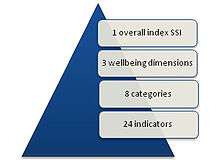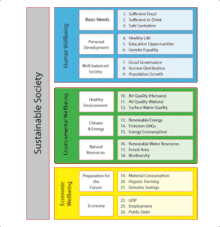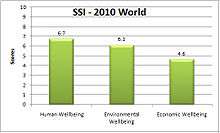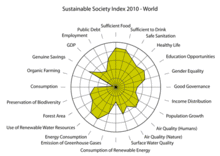Sustainable Society Index
The Sustainable Society Index (SSI) shows the level of sustainability of each of 151 assessed countries. It shows in a simple way the distance to full sustainability for each of the 24 indicators that build up the SSI.[1] The SSI is used for monitoring the progress of a country on its way to sustainability, for setting priorities with respect to sustainability, to make comparisons between countries, for education purposes, and for further research and development.

Development

The SSI was developed by Sustainable Society Foundation to provide the public at large, as well as politicians and authorities, with a transparent and easy tool to measure how sustainable a society is. The SSI is based on the Brundtland definition, and incorporates 24 indicators. These can be sorted into 8 categories, the 3 wellbeing dimensions, and finally into an overall index.
Three Wellbeing Dimensions
The Sustainable Society Index is one of the very few indices which includes all three wellbeing dimensions: Human, Environmental and Economic Wellbeing. The first two dimensions are goals to be achieved, while economic wellbeing is a necessity toward full sustainability.
2010 edition


The third edition of the SSI demonstrated that the world is behind on sustainability. The average score of all 151 countries is 5.9: 40% below the necessary level. Moreover, the world made little progress over the four years since the first edition of the SSI (2006): the overall score increased from 5.8 to 5.9. At this pace, it would take 160 years to achieve full sustainability. Moreover, since economic wellbeing scores even lower, it indicates that the world is not prepared for progress towards sustainability.
Some indicators show high scores, e.g., Sufficient Food and Sufficiency of Drink. However, since these are average scores, a score of just above 8 for these indicators means that about 20% of the world population – 1.5 billion – do not have enough food or safe drinking water. Two indicators present very low scores: Organic Farming and Consumption of Renewable Energy.
References
- "Sustainable Society Foundation". Retrieved 23 August 2013.
External links
- Geurt van de Kerk and Arthur Manuel, A comprehensive index for a sustainable society: The SSI – the Sustainable Society Index. Ecological Economics, Vol (2008) 66(2–3), pages 228–242
- ssfindex.com